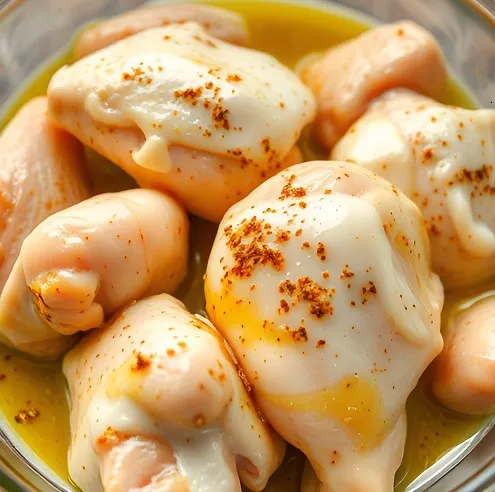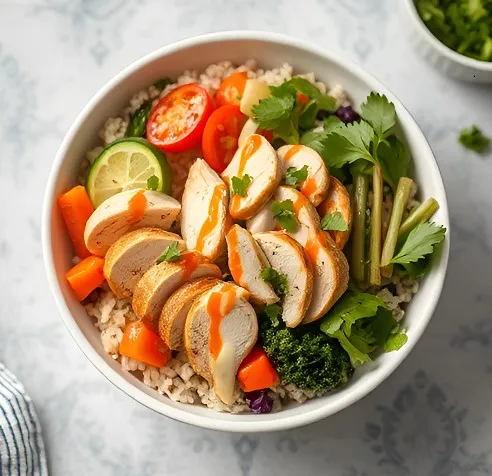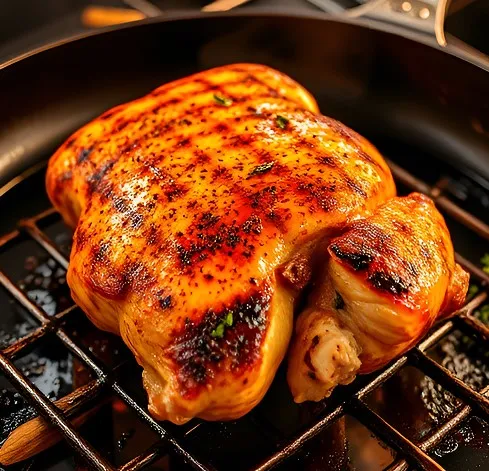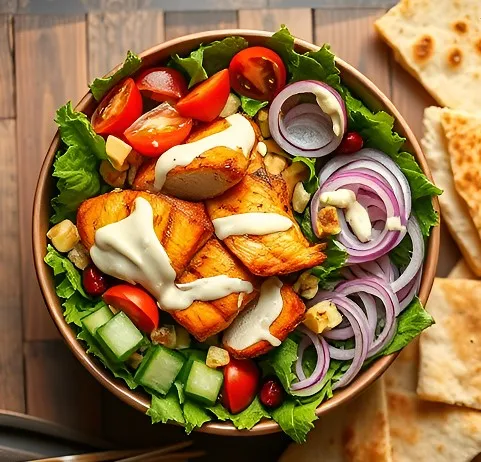The chicken shawarma bowl is a culinary masterpiece that combines the bold, aromatic flavors of Middle Eastern cuisine with the convenience of a one-bowl meal. Packed with juicy, spiced chicken, vibrant vegetables, and your choice of grains or salad, it’s a dish that satisfies both your taste buds and your hunger. Whether you’re looking for a healthy lunch, a family-friendly dinner, or a meal prep idea, the chicken shawarma bowl ticks all the boxes.
One of the best parts of this dish is its versatility. You can pair it with creamy hummus, garlic sauce, or even a tangy yogurt dressing, letting you customize it to your liking. Plus, it’s simple to prepare, making it perfect for both kitchen novices and experienced cooks. Dive into this recipe, and discover how to recreate the magic of your favorite Mediterranean restaurant at home!
Table of Contents
What is a Chicken Shawarma Bowl?
Defining Shawarma: Origins and Popularity
Shawarma is a classic Middle Eastern dish, traditionally made by roasting marinated meat on a vertical spit and slicing it thinly. Its origins trace back to the Ottoman Empire, but it has since become a global sensation, loved for its tender, flavorful meat and diverse pairings. The chicken shawarma bowl takes this traditional dish and reimagines it in a modern, convenient format. Instead of being served in a wrap or pita, the ingredients are layered in a bowl, creating a balanced and nutritious meal.
The Components of a Chicken Shawarma Bowl
At its core, a chicken shawarma bowl features marinated and perfectly cooked chicken, often seasoned with a blend of spices like cumin, paprika, turmeric, and garlic. The base can vary, ranging from fluffy rice or quinoa to fresh greens like spinach or romaine. Add-ons like crisp cucumbers, juicy tomatoes, pickled onions, and creamy tahini or garlic sauce complete the dish, offering a medley of textures and flavors.
Why This Recipe is a Crowd-Pleaser
What makes the chicken shawarma bowl so appealing is its adaptability. Whether you’re following a low-carb diet, need a gluten-free option, or simply want to pile on the grains, this dish delivers. It’s also great for meal prep since the components can be made in advance and assembled fresh when needed. Its bold flavors and vibrant presentation make it a hit for both everyday meals and special occasions.
Essential Ingredients for a Chicken Shawarma Bowl
Chicken and Marinade Ingredients
The star of a chicken shawarma bowl is the marinated chicken. Boneless, skinless chicken thighs are often preferred for their juiciness, but chicken breasts work well too. The marinade is a harmonious blend of spices, yogurt, and citrus. Common ingredients include:
- Spices: Cumin, coriander, paprika, turmeric, and a hint of cayenne for spice.
- Yogurt: Adds a creamy texture and tenderizes the chicken.
- Garlic and Lemon Juice: Enhance the tangy, aromatic flavor.
Mix these ingredients to coat the chicken thoroughly, allowing it to marinate for at least 2 hours, though overnight is even better for richer flavor.
Grains and Base Options: Rice, Quinoa, or Salad
A chicken shawarma bowl typically starts with a sturdy base. Some popular options include:
- Rice: Fluffy basmati or jasmine rice infused with turmeric or saffron for added color and flavor.
- Quinoa: A protein-packed alternative that complements the spiced chicken.
- Salad Greens: For a low-carb or lighter version, use a mix of spinach, romaine, or arugula.
Flavor-Boosting Sauces and Toppings
The sauces and toppings elevate the dish. Essential additions are:
- Tahini Sauce or Garlic Sauce: Creamy and slightly nutty.
- Fresh Vegetables: Diced cucumbers, tomatoes, and red onions for crunch.
- Pickles: Pickled turnips or cucumbers for tanginess.
- Herbs: Chopped parsley or cilantro for a refreshing finish.
Step-by-Step Recipe for a Chicken Shawarma Bowl
Preparing the Marinade and Chicken
- Gather Ingredients: Combine spices, yogurt, lemon juice, minced garlic, and olive oil in a bowl.
- Marinate the Chicken: Add chicken thighs or breasts, ensuring every piece is well-coated. Cover and refrigerate for at least 2 hours, or overnight for deeper flavor.
- Pro Tip: Score the chicken lightly with a knife to help the marinade penetrate better.

Cooking Techniques: Grilling vs. Baking
- Grilling:
Heat a grill pan or outdoor grill to medium-high heat. Cook the chicken for 5-6 minutes per side until charred and fully cooked (internal temperature of 165°F). - Baking:
Preheat the oven to 400°F. Place the marinated chicken on a baking sheet lined with parchment paper. Bake for 20-25 minutes, flipping halfway through. For extra caramelization, broil for 2-3 minutes at the end.
Assembling the Perfect Bowl
- Start with the Base: Choose rice, quinoa, or greens, and layer it in the bowl.
- Add the Chicken: Slice the cooked chicken into bite-sized strips and place it over the base.
- Top It Off: Add fresh cucumbers, tomatoes, pickled onions, and a drizzle of tahini or garlic sauce.
- Garnish: Sprinkle chopped parsley or cilantro for a burst of color and freshness.
What Do You Eat Chicken Shawarma With?
Classic Pairings: Pita Bread, Hummus, and Tzatziki
Chicken shawarma is incredibly versatile and pairs beautifully with traditional Middle Eastern staples:
- Pita Bread: Use warm, fluffy pita bread to scoop up the chicken and toppings. You can also create a shawarma wrap for a portable meal option.
- Hummus: This creamy chickpea dip complements the rich, spiced chicken with its smooth, nutty flavor. Serve it as a side or a base under the chicken.
- Tzatziki Sauce: While more common in Mediterranean cuisine, the creamy, tangy yogurt-cucumber dip is a refreshing partner for chicken shawarma.
Fresh Salads and Dips to Complement
Balance the bold flavors of chicken shawarma with light and refreshing sides:
- Tabbouleh: A parsley and bulgur wheat salad with fresh tomatoes, cucumbers, and lemon dressing.
- Fattoush: Crisp, tangy salad made with lettuce, fried pita chips, and a zesty sumac dressing.
- Baba Ganoush: A smoky eggplant dip that’s rich yet subtle enough to let the shawarma shine.
These sides not only enhance the meal but also add a variety of textures and flavors, making every bite exciting.

What is Shawarma Made Of
Traditional Shawarma Ingredients
Shawarma originated as a street food, where marinated meat is slow-cooked on a vertical rotisserie. The traditional ingredients depend on the type of meat being used:
- Chicken Shawarma: Typically marinated with a blend of spices (cumin, turmeric, paprika), yogurt, and lemon juice to enhance flavor and tenderness.
- Beef or Lamb Shawarma: Uses similar spices but often includes cinnamon or allspice for a deeper, earthy flavor.
The cooking process is what makes shawarma truly special. As the meat cooks, it is sliced thinly from the spit, ensuring every piece is tender and infused with smoky, spiced flavor.
Modern Variations and Adaptations
While traditional shawarma involves a rotisserie, modern adaptations have made it accessible for home cooks:
- Stovetop or Grill: Pan-fry or grill marinated chicken for a quick and flavorful alternative.
- Oven-Baked: Baking the marinated meat is another simple way to replicate the tender, juicy texture.
Additionally, creative variations like vegan shawarma made with jackfruit or tofu have gained popularity, allowing everyone to enjoy the bold flavors of this iconic dish.
What Are the Two Types of Shawarma?
Chicken vs. Beef/Lamb Shawarma
The two most popular types of shawarma are chicken and beef/lamb, each offering a unique flavor profile:
- Chicken Shawarma: This variation is often marinated in a yogurt-based mixture with spices like cumin, turmeric, and paprika. The yogurt tenderizes the meat, resulting in juicy and flavorful chicken that pairs well with lighter toppings like fresh vegetables and garlic sauce.
- Beef or Lamb Shawarma: These meats are typically marinated in a blend of warm spices, including cinnamon, allspice, and nutmeg, which give them a deeper, richer taste. The meat is fattier than chicken, creating a luscious, melt-in-your-mouth texture. It pairs well with tahini sauce and pickled vegetables.

Key Differences in Flavor and Preparation
- Flavor: Chicken shawarma is lighter and tangier, while beef or lamb shawarma has a bold, savory profile.
- Texture: Chicken tends to be tender and lean, while lamb or beef often contains a higher fat content, contributing to a juicier bite.
- Cooking Techniques: Both types can be grilled, baked, or slow-cooked, but the choice of meat and marinade significantly impacts the final taste.
By understanding these differences, you can choose the type of shawarma that best suits your palate or experiment with both for variety.
Is Chicken Shawarma the Same as Gyros?
Comparing Shawarma and Gyros: The Basics
At first glance, chicken shawarma and gyros may seem similar—they both feature spiced meat served with toppings and sauces, often in wraps or bowls. However, there are notable differences:
- Meat Preparation:
Shawarma is typically marinated with a mix of Middle Eastern spices and slow-cooked on a vertical spit. Gyros, a Greek dish, is seasoned with herbs like oregano, thyme, and rosemary, creating a distinct Mediterranean flavor. - Accompaniments:
Shawarma is often served with tahini, garlic sauce, or pickled vegetables, while gyros are paired with tzatziki sauce and fresh vegetables like tomatoes and onions.
Regional and Cultural Differences
- Origins: Shawarma has roots in the Middle East, with influences from countries like Lebanon and Turkey, whereas gyros hail from Greece.
- Spices and Herbs: Shawarma features bold, aromatic spices like turmeric, cumin, and cinnamon. Gyros rely on lighter, herbaceous flavors.
- Serving Style: Shawarma bowls are common in modern adaptations, offering a healthier, deconstructed option. Gyros are more traditionally served as wraps.
While they share similarities, chicken shawarma and gyros reflect their respective cultural and culinary traditions, offering distinct experiences for food lovers.
Tips for Making the Best Chicken Shawarma Bowl
Selecting the Right Spices and Ingredients
The key to an authentic chicken shawarma bowl lies in the spices and fresh ingredients:
- Spices: Use a blend of cumin, turmeric, paprika, coriander, and garlic powder. A dash of cayenne adds heat, but adjust to your preference.
- Marinade Base: Yogurt is a must for tenderizing the chicken and creating a rich, tangy flavor. Fresh lemon juice amplifies the zest.
- Fresh Produce: Opt for crunchy cucumbers, ripe tomatoes, and crisp lettuce to balance the richness of the chicken.
Meal Prep Hacks for Busy Days
- Marinate in Advance: Prep the chicken and let it marinate overnight for maximum flavor. You can freeze marinated chicken for up to a month.
- Batch Cooking: Cook a large batch of chicken and divide it into portions for multiple meals. Store in airtight containers for up to four days in the refrigerator.
- Prep Toppings Ahead: Chop vegetables, prepare sauces, and cook grains in advance. Store everything separately to maintain freshness.
Storing and Reheating Shawarma Bowls
- Storage: Keep each component in separate containers to avoid sogginess. Store grains, vegetables, and chicken in airtight containers in the fridge.
- Reheating: Warm the chicken in a skillet over low heat to preserve its juiciness. Avoid microwaving the entire bowl as it may wilt the fresh veggies.
With these tips, you can easily enjoy delicious chicken shawarma bowls throughout the week without compromising flavor or quality.
Frequently Asked Questions
What Do You Eat Chicken Shawarma With?
Chicken shawarma is a versatile dish that pairs well with a variety of sides. Popular options include:
- Pita Bread: Serve alongside or use it to wrap the shawarma for a handheld meal.
- Dips: Hummus, baba ganoush, or tzatziki complement the bold flavors.
- Salads: Tabbouleh, fattoush, or simple cucumber-tomato salads add freshness.
What Is Shawarma Made Of?
Shawarma is traditionally made with marinated meat—chicken, beef, or lamb—cooked on a vertical spit. The marinade often includes spices like cumin, coriander, and turmeric, along with yogurt and lemon juice for flavor and tenderness. Modern adaptations also include vegan options like jackfruit or tofu.
What Are the Two Types of Shawarma?
The two most common types are:
- Chicken Shawarma: Marinated with lighter spices and yogurt, often paired with fresh toppings and garlic sauce.
- Beef/Lamb Shawarma: Features richer, spicier marinades with earthy spices like cinnamon and allspice.
Is Chicken Shawarma the Same as Gyros?
While similar in appearance, shawarma and gyros differ in flavor and origin:
- Shawarma: Originates from the Middle East, marinated with aromatic spices like turmeric and cumin.
- Gyros: A Greek dish seasoned with herbs like oregano and thyme, served with tzatziki.
Can I Make Chicken Shawarma Bowls Gluten-Free?
Absolutely! Replace pita bread with gluten-free flatbread or skip it entirely. Use quinoa or a salad base instead of grains containing gluten.
How Do I Make a Vegan Shawarma Bowl?
For a vegan version, use marinated jackfruit, tofu, or seitan as the protein. Pair it with plant-based sauces like tahini or hummus for a delicious and satisfying meal.
Conclusion
The chicken shawarma bowl is the perfect fusion of bold Middle Eastern flavors and modern convenience. From its juicy, spiced chicken to its vibrant toppings and customizable base, this dish is a testament to how simple ingredients can create extraordinary meals. Whether you’re a seasoned cook or a beginner, this recipe is approachable, versatile, and guaranteed to impress.

